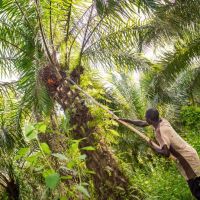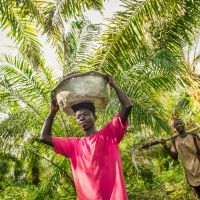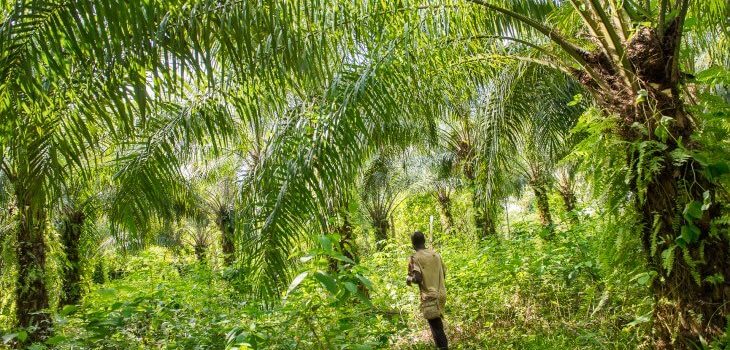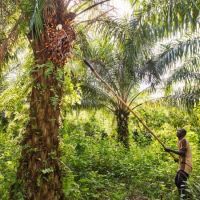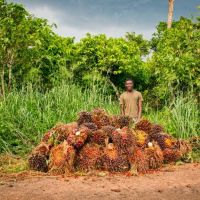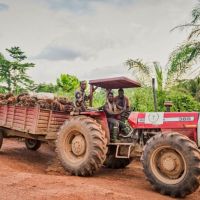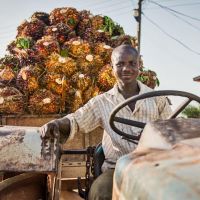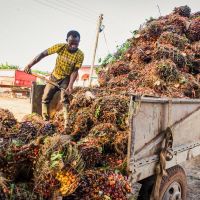All of Dr. Bronner’s agricultural projects are committed to producing raw materials without using agrochemicals. This requires the active pursuit of sustainable agriculture, now often referred to as regenerative agriculture. Since we started Serendipalm, implementation of organic methods has encompassed more than just the eschewal of chemical fertilizers, pesticides, and herbicides. Rather, it has become an essential element of fair and organic practices to support farmers with improving soil fertility and farm profitability. Closing the nutrient loop and motivating farmers to improve the care of their land is key to this enterprise. We recognized early on that poor farm maintenance produced low yields of fresh fruit bunches (FFB). For this reason, our first fair trade projects gave farm maintenance loans to farmers to help them finance weeding and mulching of their land. We then organized the return of all biomass waste from palm oil production to the fields—to be used as mulch. Since 2013 Serendipalm has financed a seedlings program, issuing seedlings of more productive local varieties to farmers using interest-free loans. By now, about 110,000 palms have been planted and are gradually replacing older, low-yielding trees. To improve biodiversity, we stipulated that farmers include fruit and timber trees in these newly planted fields. The results speak for themselves: since 2010 the average FFB yield per acre rose by about 30% and thereby improved farm income considerably—using only natural methods.
Dynamic Agroforestry – a Concept for our Planet’s Future
Our farmers’ cocoa and oil palm fields are small, typically 5-8 acres, surrounded by a patchwork of small fields of cocoa, citrus and field crops. Even so, they are monocultures that don’t foster biodiversity and do not make optimum use of natural resources and the synergies between plant communities.
In 2016, we were introduced to the concept of “dynamic agroforestry” (DAF), which involves the planting of cocoa, oil palm, and other timber and fruit trees in stratified mixed cultures. This simulates the succession of trees in natural tropical forests and optimizes the utilization of sunlight and of the microbial life present in the soil. The advantages of DAF for the farmer? Much higher planting densities achieve 2 to 3 three times the yields of even well-kept cocoa and oil palm monocultures. The higher farm output is produced throughout the year, helping to diversify farm income and improve food security. The high biodiversity reduces pest pressure while the high growth rates of trees achieve better sequestration of atmospheric carbon dioxide, helping to counter the effects of climate change. In cooperation with the German-Bolivian DAF experts at Ecotop, we started a program in late 2016 to support farmers who want to replant using DAF concepts. For training and demonstration, we first created two DAF demonstration farms. The photo shows part of our 5-acre demonstration farm near Abaam. For better visualization of the concept, please watch the video of a larger DAF planting in Ivory Coast, also developed by Ecotop.
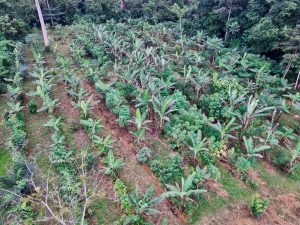
The picture shows our DAF plot development.
Training by Ecotop and Serendipalm’s field officers support farmers with the shift to DAF. It also requires financing, since DAF plantings have a higher cost for seedlings and skilled labor. Serendipalm’s support includes the training of field workers and marketing support for DAF byproducts, such as bananas or turmeric. After experimenting and demonstrating DAF for two years in Ghana and at our sister project SerendiCoco Samoa we are convinced that it is among the most promising options for strengthening smallholder agriculture in the tropics—with the potential of slowing down climate change as an additional dividend. No wonder we are accelerating the roll-out of our DAF program in Ghana and Samoa, with support from international development programs.
The following gallery shows the production steps on the field.
